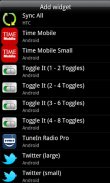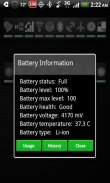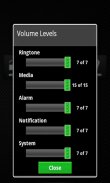





Toggle It

Descrizione di Toggle It
* Deprecated app. Some features may not work with the latest Android Smartphones. There is no longer technical support for this app. It's free of charge, as-is. Thank you.
Do you like weeding through menus and sub menus of options to find the setting in your Android Smartphone that you want to change? Ya, we don't either. With Toggle It you can easily, quickly add toggle widgets, from one to as many as your Android device's screen can hold.
Once you add a toggle widget to your Android device's home screen it's as easy as pressing on it to turn it on and off.
Unlike the default Android Power control widget set that only allows for five toggle widgets, which cannot be changed, Toggle It lets you, the user, put as many different toggle widgets as you want on your device's home screens!
Current Toggle Widget Set:
Ringer - switch between normal, silent, and vibrate only for incoming phone calls
Phone Signal - turn off all telephony transmission signals, which can really save a lot of battery power
Mobile Data - enable to disable 2G/3G connectivity. This is especially handy if your Android device wireless device plan is not unlimited.
WiFI - enables or disables the WiFi connection on the device.
WiFi Tethering - enables or disables WiFi Tethering feature on the Android device. (Android 2.2+)
Bluetooth - enables or disables Bluetooth feature. (e.g. Bluetooth headset use)
GPS - Due to Google's Android OS changes, the GPS Toggle It widget is no longer able to be offered.
Airplane Mode - enables or disables all signal, transmissions to and from the Android device. Often used when flying, thus the toggle name.
Sync - enables or disables the Sync All feature. (e.g. if enabled will periodically sync all of the Google accounts associated with the Android device).
Auto-Rotate Screen - enables or disables the ability to rotate the screen via the related scensor. (e.g. whether the browser rotates into landscape mode from portrait and reverse, or just locks into portrait mode)
User Set Brightness - this toggle widget allows the user, with a swipe of their figner, to adjust the screen brigthness.
Screen Time Out - allows the user to change the time that elapses before the screen turns off. The values that can be set are 15 seconds, 30 seconds, 1 minute, 2 minutes, 10 minutes, or 30 minutes.
Screen Always On - when enabled the Android device's screen will stay on until the user pushes the power button. When this toggle widget is enabled, the Screen Time Out will be disabled.
Screen Brightness - this toggle widget allows the user to quickly switch from four different screen brightness values. Which include, minimal (lowest brightness), Auto (the actual lighting in the area of the device will dictate the brightness, thanks to the device's built-in sensor for such), User Set (this is the value that can be set with the User Set Brightness toggle), and finally Max, for maximum screen brightness.
Flashlight - will turn on or off the Flash or LED that is on the back of many Android devices, and set the brightness to its highest level.
SD Card (External Storage) - when pressed on this toggle widget will scan the device to a degree for files (e.g. media, music, etc.). It also will popup a message stating the amount of SD card (External Storage) available, and the overall size of the storage.
Haptic Feedback - when enabled will turn on the slight vibration feeling the user feels when pressing on certain User Interface areas, such as the "soft keys" (the hardware keys, e.g. Home, Back, Menu, and Search) on the Android device.
Battery - shows the current battery level (updates on 1% changes) on the toggle. Once clicked it shows the current status of the battery. Clicking on the popup dialog's Usage or History buttons will give even more in-depth information about what has been using the battery, back to when the first devices turned on.
Volume - change volume levels.
Keywords: toggle, widget
</div> <div jsname="WJz9Hc" style="display:none">* App obsoleto. Alcune funzionalità potrebbero non funzionare con gli ultimi smartphone Android. Non c'è più il supporto tecnico per questa applicazione. E 'gratuito, così com'è. Grazie.
Ti piace diserbo attraverso i menu e sotto menu di opzioni per trovare l'impostazione nel vostro smartphone Android che si desidera modificare? Ya, non lo facciamo neanche. Con Toggle esso si può facilmente, aggiungere rapidamente i widget a levetta, da uno a ben schermo del vostro dispositivo Android può contenere.
Una volta che si aggiunge un widget di commutazione alla schermata principale del dispositivo Android è semplice come premere su di esso per accendere e spegnere.
A differenza del widget di controllo insieme potenza Android di default che consente solo per i widget cinque ginocchiera, che non può essere cambiato, Toggle Ti consente, all'utente, messo come molti widget ginocchiera differenti come si desidera su schermate Home del dispositivo!
Corrente Toggle Widget Set:
Ringer - passare da normale, silenzioso, e vibrare solo per le chiamate in arrivo
Segnale del telefono - spegnere tutti i segnali di trasmissione di telefonia, che può davvero risparmiare un sacco di energia della batteria
Mobile Data - permetterà di disattivare la connettività 2G / 3G. Ciò è particolarmente utile se il tuo piano di dispositivo wireless dispositivo Android non è illimitata.
Wi-Fi - attiva o disattiva la connessione Wi-Fi sul dispositivo.
WiFi Tethering - abilita o disabilita funzione WiFi Tethering sul dispositivo Android. (Android 2.2+)
Bluetooth - attiva o disattiva la funzione Bluetooth. (Uso auricolare Bluetooth per esempio)
GPS - A causa dei cambiamenti del sistema operativo Android di Google, il GPS Toggle E widget di Non è più in grado di offrire.
Airplane Mode - attiva o disattiva tutti i segnali, le trasmissioni da e verso il dispositivo Android. Spesso usato durante il volo, da cui il nome di commutazione.
Sync - abilita o disabilita la sincronizzazione tutte le funzionalità. (Ad esempio, se abilitato periodicamente sincronizzare tutti degli account Google associato al dispositivo Android).
Rotazione automatica dello schermo - abilita o disabilita la possibilità di ruotare lo schermo tramite il relativo scensor. (Ad esempio, se il browser gira in modalità orizzontale da verticale e invertire, o semplicemente si blocca in modalità verticale)
User Set Luminosità - questo widget levetta permette all'utente, con un colpo di loro Figner, per regolare il brigthness schermo.
Schermo Time Out - consente all'utente di modificare il tempo che deve trascorrere prima che lo schermo si spegne. I valori che possono essere impostati sono 15 secondi, 30 secondi, 1 minuto, 2 minuti, 10 minuti o 30 minuti.
Schermo Always On - quando abilitata schermo del dispositivo Android rimarrà fino a quando l'utente preme il pulsante di accensione. Quando questo widget di commutazione è abilitata, verrà disattivata la schermata Time Out.
Luminosità dello schermo - questo widget levetta permette all'utente di passare rapidamente da quattro diversi valori di luminosità dello schermo. Che comprendono, minima (luminosità più bassa), Auto (dell'illuminazione reale nell'area del dispositivo detterà la luminosità, grazie al dispositivo sensore incorporato per tale), User Set (questo è il valore che può essere impostato con il user Set Brightness Toggle), e infine Max, per massima luminosità dello schermo.
Torcia elettrica - si accende o spegne il flash o LED che si trova sul retro di molti dispositivi Android, e impostare la luminosità al suo livello più alto.
SD Card (Storage esterno) - quando viene premuto su questo widget levetta esplorerà il dispositivo ad un grado per i file (ad esempio i media, musica, ecc). Inoltre popup un messaggio che indica la quantità di scheda SD (External Storage) a disposizione, e la dimensione complessiva dello stoccaggio.
Haptic Feedback - se attivato si accende la leggera vibrazione sentendo l'utente si sente quando si preme su determinate aree dell'interfaccia utente, come ad esempio i "tasti soft" (i tasti hardware, ad esempio a casa, torna, Menu, e di ricerca) sul dispositivo Android.
Batteria - mostra il livello attuale della batteria (aggiornamenti sul 1% modifiche) sulla leva. Una volta cliccato mostra lo stato corrente della batteria. Facendo clic sui pulsanti di utilizzo o la storia della finestra di dialogo pop-up vi darà informazioni ancora più approfondite su quanto è stato utilizzando la batteria, indietro a quando i primi dispositivi accesi.
Volume - livelli di volume di cambiamento.
Parole chiave: ginocchiera, widget di</div> <div class="show-more-end">


























